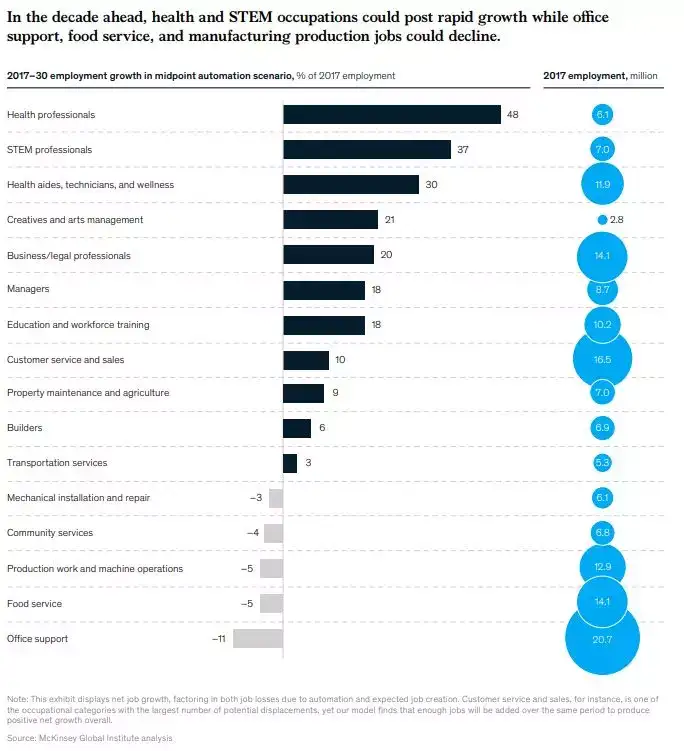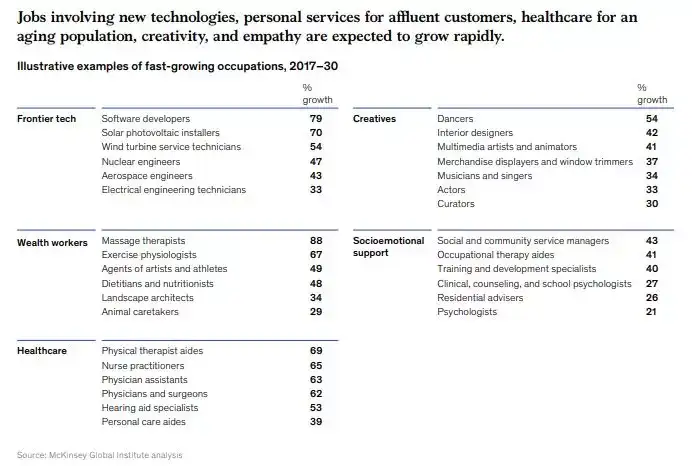One: Employment trends in the United States in the next ten years (McKinsey report)
a. Generally speaking, the United States will continue to grow in employment in the next ten years.
b. McKinsey predicts that employment will continue to grow in the fields of health care, STEM technology, creation and management, business and law, management, education and vocational training, customer service and sales, property management, agriculture, construction, and logistics in the next decade.
c. Health and STEM-related job growth are higher than 30%. The growth of STEM is not difficult to understand. The increase in the number of health and medical positions is mainly because people want to live a healthier life to extend their lifespan, and life extension leads to global aging.
d. Mechanical installation and maintenance, community service, assembly line and machine operation workers, catering services, and basic office workers will lose their jobs due to artificial intelligence in the next ten years.
McKinsey predicts fast-growing jobs in the five major areas of cutting-edge technology, creation, wealth, social-emotional support, and healthcare within the next decade.
a. Frontier technology: software developers
b. Creation category: interior designers, multimedia and animators, and display designers, etc.
c. Wealth management: nutritionist; broker; exercise physiology expert; wealth manager, etc.
d. Social and emotional support: trainers, clinical / consulting, and school psychologists, etc.
e. Healthcare: physical therapist; nurse; physician assistant; doctor; personal care assistant, etc.
In the future work, more and more employees will be required to have a high cognitive ability (creativity, ability to handle complex information to solve problems), social and communication (proactive, leadership and management skills), and technical ability (programming ability/data processing ability).
Two: The relationship between the world’s major powers will become more complex in the next decade

a. Six major countries in the world: the United States, China, Russia, the European Union (as a whole, its operational capacity is equivalent to a large country), Japan, India
Brazil has not been counted, although it is large enough to become a big country, unfortunately, its ability to act is relatively poor.
The Amazon forest of the largest lung in the earth is in Brazil, and the Amazon River, the kidney of the earth, is also in Brazil. How rich is the water? Even in the dry season, its water volume is 8 times that of the Yangtze River.
The place in Brazil is that the conditions are too good. If it is too good, it will be easy to have problems: looseness and poor organizational ability, and human progress are basically measured by organizational ability.
Russia has a relatively small population of 142 million people and a birth rate of only 0.67. A woman cannot have a child; the population of Europe and Japan is also aging. From the perspectives of population, resources, and national organizational capabilities, the situation in China, the United States, and India is better.
b. The future of Sino-Japanese relations must be very troublesome
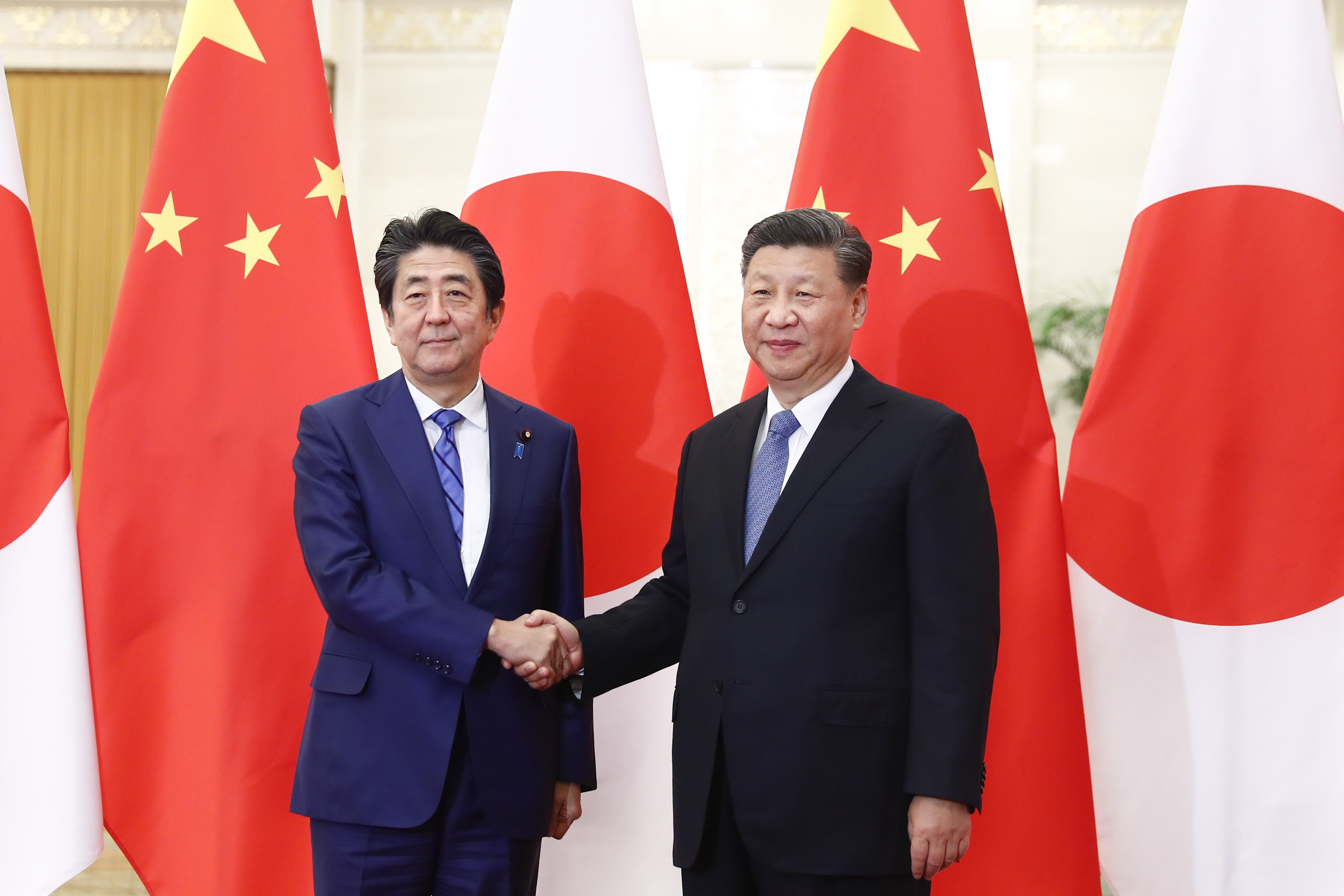
Japan, I personally think that it is the most difficult of all countries in the world to accept China ’s rise, because Japan has two psychology that other countries do not have, one is stupid racism against China, the other is a very deep crime sense.
The prerequisite for Japan to have a technological advantage is that the Chinese have refused to learn. As long as the Chinese begin to learn, it is only a matter of time before they catch up with him in technology.
Japan ’s high-speed rail is called the Shinkansen, and they feel that they are alone in the world. Now they clearly know that China ’s high-speed rail is better than them. France, Japan, and China are the three major high-speed rail systems in the world. We are the best. Japan ’s Shinkansen has a top speed of 246 kilometers per hour, France has 272 kilometers, and in China, it ’s less than 300 kilometers per hour. According to Chinese standards, there is no high-speed rail in Japan. How can speed of 246 kilometers be called high-speed rail?
China belongs to a particularly good country among the big powers. Japan actually passed the mistake, but he just didn’t recognize the mistake, so the future of Sino-Japanese relations must be very troublesome.
C. Sino-Indian relations must also be very troublesome in the future
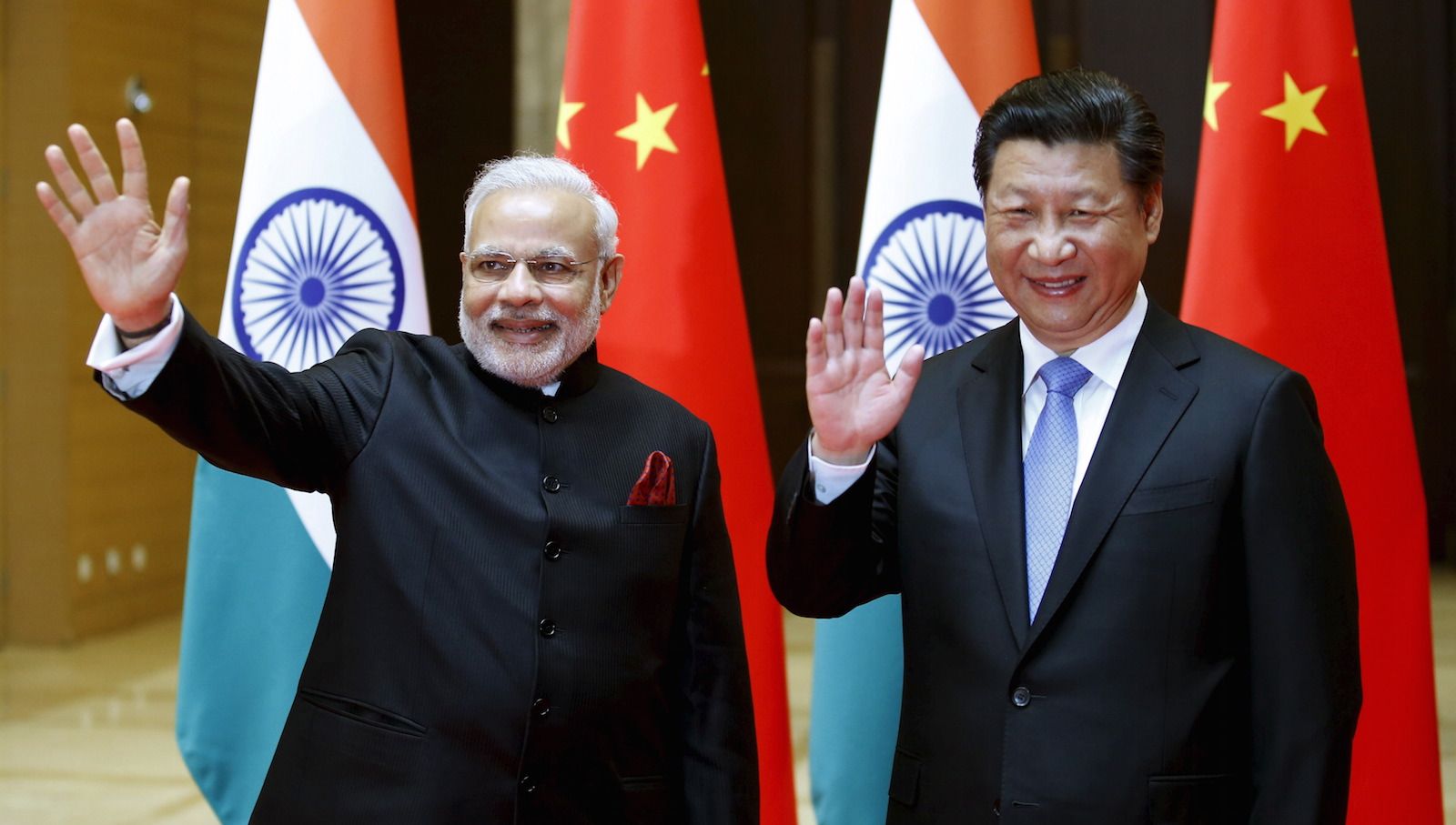
This is a very real problem because of border conflicts. Then objectively, we have risen at the same time and are in a situation of strategic competition.
Three: Medium-sized powers in the next decade deserve more attention
In my mind, the four medium-sized powers that we should pay special attention to in the future are Vietnam, Indonesia, Iran, and Turkey.
a. Vietnam

Vietnam ’s industrialization should be good. It has industrialization capabilities, and it has a population of more than 90 million, which will soon be over 100 million. The population base is there and industrial capabilities are also available.
The results of the international Olympic numbers came out, South Korea ranked first, China ranked second, and Vietnam ranked third. I think Vietnam is still a very powerful country, and then its diplomatic strategy is also very good, which deserves attention.
b. Indonesia

Indonesia ’s location is important, and it can benefit from the rise of China and India. The strategic center of the United States has come here again, and the three very influential countries will be here in the future. He can use this force. Indonesia itself has a huge population base, good resources and environment, and good regional conditions.
c. Iran
Iran has a long civilization, and its 5000-year cultural heritage is very good. The population of this nation is also quite large, and the country ’s land area of more than 1.6 million square kilometers is not small. I think the rise of Iran, the first hero is the United States, and the second is it’s own.
In fact, Iran was very uncomfortable for some time. After the Green Revolution in 1979, the entire West suppressed it because of the American hostages. The Sunni world suppressed it. With the joint support of the West and Saudi Arabia, Saddam went to beat him. Iran and Iran Eight and a half years after the war, Iran killed more than 4.6 million people.
He was beaten militarily, politically isolated, and economically very difficult, because after the second oil crisis in 1979, Westerners de-industrialized, and then the price of oil fell. Iran relied on oil, so it has been economically for a long time. Very difficult. But in this century, with the help of Americans, it is now salted fish turned over and alive. For example, the first thing the United States does is to kill its old enemy Saddam.
Iran does not have that much pressure on security, diplomacy has also changed, and oil prices have risen in recent years, and its economy has come alive, so Iran is now in a much better position than it was a decade ago, and it remains optimistic in the future.
In addition, why is Israel particularly afraid of it?
Because it is likely to be the only country in the Muslim world that has a real threat to Israel in the future, other people really do not have this ability. Because Israel is particularly afraid of it, the United States is influenced by Israel, and it is now necessary to correct it.
But no matter how it collapses, Iran will still be an independent Middle East force and play a role.
d. Turkey

Turkish President Erdogan is very ambitious. He wants to implement neo-Ottomanism, which will bring many variables to the Middle East.
Four: Development trend in the next decade
a.Federal learning

By running a centralized data set, the value can be extracted from the data. But as the volume of data increases, data centralization becomes more and more difficult.
The solution to this problem is a new field of machine learning, known as federated learning. Instead of sending data to algorithms, federated learning sends data to algorithms.
You may have experienced the benefits of federal study without realizing it. When you type text on your phone, as you type, the input method gives you several possible choices. These input Suggestions are actually generated by the machine learning model.
Privacy laws prohibit apple, Google, and others from sending your personal messages to their learning algorithms. So they use federal learning to train the model on your phone.
The benefits of user privacy come at the expense of running algorithms on the device. Federal learning is suitable for applications that are concerned about privacy.
b. E-sports and entertainment

Esports will become a bigger industry than most regular sports.
“We’re basketball, we’re the NBA, we’re a little bit of ESPN” — Netflix explains esports
You might hear the captain speak briefly after a traditional sporting match. In esports, the whole team is constantly being streamed live. This makes it easier for viewers to understand the storyline of esports. And game companies are constantly tweaking the rules of the game to make it more entertaining.
c. Blockchain and bitcoin

Blockchain is a feature, and trust is the benefit of that feature.
There’s been a lot of talk about the key to bringing blockchain into the mainstream. Key management is still difficult. I believe the adoption of blockchain technology will mainly happen behind the enterprise supply chain.
It is difficult to transform existing processes with blockchains. It requires the support of multiple stakeholders and the acquisition of trusted data from down the chain in order to form the chain. To be accepted into the mainstream, key management, storage, and recovery needs to be addressed.
According to bitcoin, rewards to miners are cut in half for every 210,000 blocks dug, a so-called halving. By mid-2020, it will have halved for the third time, which many predict will lead to a new bull market. John McAfee is confident (he predicts that bitcoin will reach $500,000 by the end of 2020). I hope they’re right.
Bitcoin failed as a currency, but it succeeded as a store of value.
d. no one car
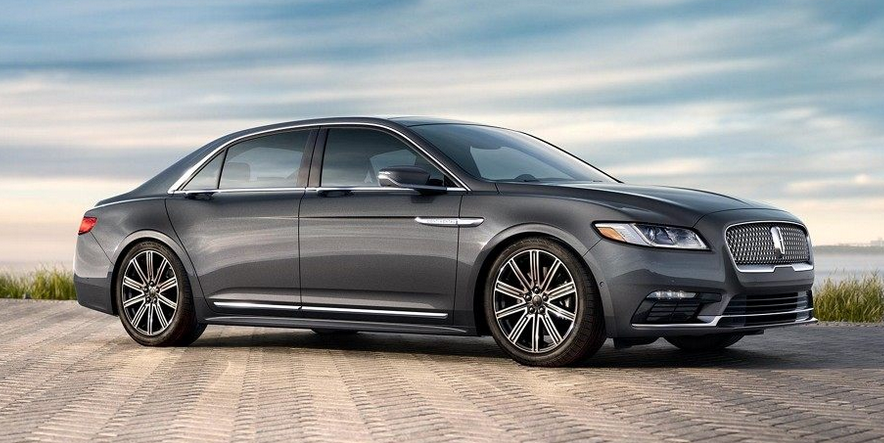
The adoption of driverless cars will be slow because of regulatory constraints, but eventually capitalism will win.
Transportation costs will be close to zero.
Netscape provided the platform for Amazon, Google, and Facebook, and driverless fleets will be the new platform to be developed. When the cost of delivery falls to zero, it will open up new business models that make no sense now, such as:
Motorized food preparation so that your pizza is fresh out of the oven by the time you get there.
Predictive delivery, the order is sent out before the product arrives.
Mobile office during commuting time.
The family showroom for “help me make a generation” makes returning goods as easy as delivering them.
Use things with low utilization on-demand.
The principle of just-in-time manufacturing will drive the rise of just-in-time consumption.
e. the world population will increase by 1 billion by 2030, and the overall weather will continue to warm
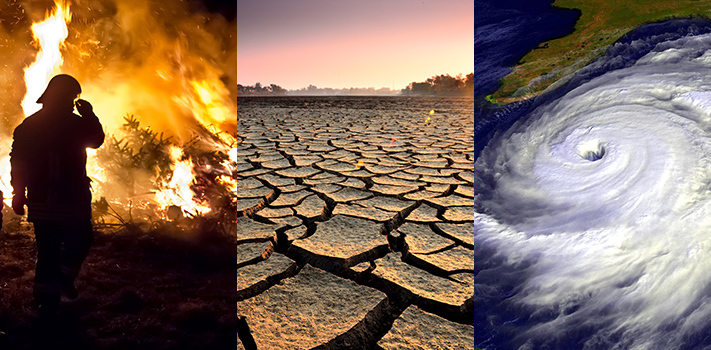
According to the UN department of economic and social affairs’ world population outlook 2019 report, the global population will reach 8.5 billion by 2030.
The aging population is growing fastest, with about one in eight people over 65.
For the next decade, until the end of the 21st century, Africa will have the world’s fastest-growing working-age population.
According to UN experts, 60 percent of the world’s population will live in cities by 2030, and the number of cities with one million people will increase from 548 in 2018 to 706.
By 2030, the total number of people born after 2000 will exceed 2 billion, making them the backbone of political, economic, and social life.
By 2030, global temperatures will rise by 1.5 degrees Celsius. Climate change will profoundly affect the global economy. Climate change will cost the world $2 trillion in lost production, the independent reported. The world bank report says Africa’s agriculture sector could see a total growth opportunity of $1 trillion.
f. e-commerce is booming

E-commerce will become the main mode of international trade and the engine of economic growth.
According to the statistics of unctad, the global e-commerce sales volume exceeded 29 trillion us dollars in 2019, of which 88% were B2B and 12% were B2C. The total size of B2C was 412 billion us dollars, mainly in China. China, India, and South Africa are the fastest-growing countries for e-commerce.
19.2 percent of Russian Internet users use e-commerce, up from the global average of 16 percent. Mobile payments will soon become universal in countries with better banking systems. According to ZDNet, 86 percent of Chinese are online wallet users, ranking first in the world. Indonesia, Thailand and the Philippines are among the world’s top 10 countries for mobile adoption, according to PWC. Mobile payments are rapidly spreading around the world.
All sorts of signs show B2C will become the main form of global electronic commerce. For example, Lazada group, an e-commerce portal funded by Alibaba, announced that it will support 8 million e-commerce entrepreneurs and small and medium enterprises in Southeast Asia by 2030.
In the next decade, most of the world’s population will be deeply integrated into the financial credit system.
Under the new trade model, economic sanctions, unilateralism, and protectionism will lose their effectiveness and fail to prevent the rise of global and regional emerging economies.
Post time: May-27-2020

